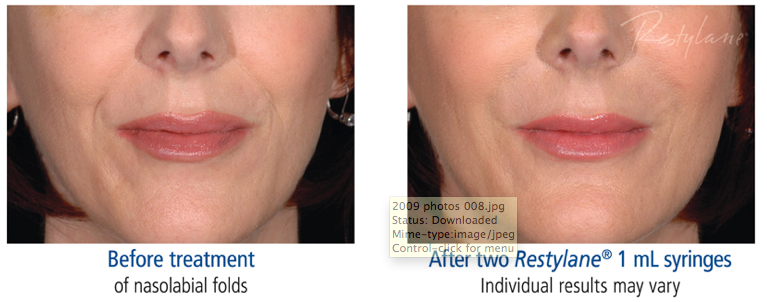The Restylane Family of Dermal Fillers
Restylane® is an innovative dermal filler, designed to plump facial tissues and restore a youthful appearance. Restylane was the first dermal filler on the U.S. market to be made from Hyaluronic Acid (HA), a natural component of healthy human tissues. As an important structural building block in the skin, HA is responsible for ramping up the body’s collagen production. The HA also naturally draws in water from the body, plumping tissues for long-term benefits. A Restylane treatment provides immediate volumizing to the tissues, and while the body’s collagen stores are being rebuilt, the benefits from treatment can last for months. This unique family of dermal fillers includes Restylane, Restylane Lyft, Restylane Silk, Refyne, and Defyne; each is purposefully designed to treat specific areas of the face.
Restylane - for facial wrinkles and folds
Restylane Defyne - for deep smile and laugh lines
Restylane Refyne - for moderate smile and laugh lines
Restylane Lyft - for cheeks, facial wrinkles and back of hands
Restylane Silk - for lips and the lines around them
What is Restylane?
Restylane is a clear gel formulation of hyaluronic acid that is specifically formulated to act like your body's own naturally produced hyaluronic acid, helping to visibly correct moderate to severe facial wrinkles and folds, including the lines that run from your nose toward the corners of your mouth (nasolabial folds) and the lines that run from the corners of your mouth toward the chin (marionette lines).
Additionally, Restylane and Restylane® Silk are FDA-approved for lip enhancement in patients over the age of 21, and are uniquely formulated to give your lips fullness and definition.
HOW LONG DOES RESTYLANE LAST?
A Restylane effects generally last at least *six months and gradually disappears from the body. If you are treated again at 4 ½ or 9 months after your first treatment, Restylane can last up to *18 months in the nasolabial folds. In the lips Restylane generally lasts *six months.
WHO SHOULD NOT USE RESTYLANE?
The Restylane family of products should not be used by people who:
are pregnant, breastfeeding, or under 18 years for nasolabial folds and under 21 years for lips (Restylane and Restylane-L only).
have recently used drugs that thin the blood or prevent clotting
have had previous bad allergies, particularly to microorganisms known as gram-positive bacteria
have serious allergies to drugs that have previously required in-hospital treatment
have bleeding disorders
have a known allergy to lidocaine, if using Restylane-L or Perlane-L
*Patient disclaimer
Before + After Gallery
WHAT SHOULD PATIENTS DO PRIOR TO TREATMENT?
Restylane requires no pretesting, but you should take a few precautions before being treated. Avoid using St. John’s Wort, high doses of Vitamin E supplements, aspirin, and other non-steroidal anti-inflammatory medications, such as ibuprofen prior to treatment, because these may increase bruising or bleeding at the injection site. Also, if you have previously suffered from facial cold sores, discuss this with your physician. He or she may consider prescribing a medication to minimize recurrences.
AFTER TREATMENT:
Cold compresses (a cloth dipped in cold water, wrung out, and applied to the injected area) may be used immediately after treatment to reduce swelling.
Avoid touching the treated area within six hours following treatment so you do not accidentally injure your skin while the area is numb. After that, the area can be gently washed with soap and water.
Until there is no redness or swelling, avoid exposure of the treated area to intense heat (sun lamp or sun bathing).
If you have previously suffered from facial cold sores, there is a risk that the needle punctures could contribute to another occurrence. Speak to your physician about medicine to prevent this from happening again.
If you have previously suffered from facial cold sores, there is a risk that the needle punctures could contribute to another occurrence. Speak to your physician about medicine to prevent this from happening again.
WHAT ARE SOME POTENTIAL RISKS YOU MAY ENCOUNTER?
As with all procedures like this, the injection of Restylane carries a risk of infection and formation of scar tissue. The safety and effectiveness of Restylane has not been established in pregnant, or nursing
mothers, and in patients under 18 or over 65 years of age. Restylane use in nursing could harm you or the nursing child. Restylane should not be used for lip enhancement in patients
under the age of 21. The use of Restylane in African-American patients can result in hyperpigmentation
(darkening of skin color), which may take several weeks to correct. If you have previously had facial cold sores, an injection can cause them to come back. The safety of Restylane used with other skin therapies such as laser, mechanical or chemical peeling, and hair removal has not been established. The use of Restylane with these skin therapies may lead to other side effects such as inflammation. You should avoid exposing the area(s) treated with Restylane to excessive sun or UV lamps, and extreme heat and cold until any redness or swelling has disappeared.
*Disclaimer: Results may vary from person to person.







